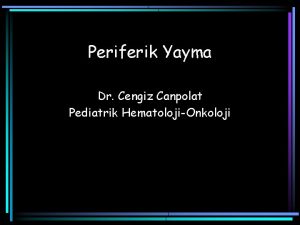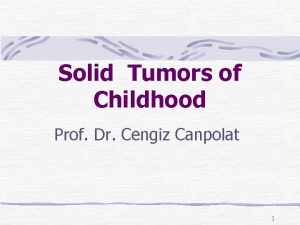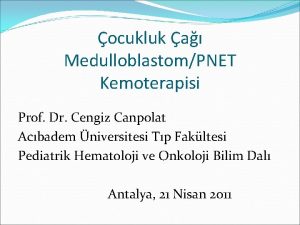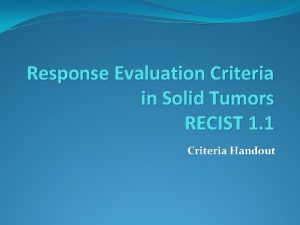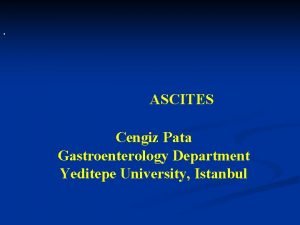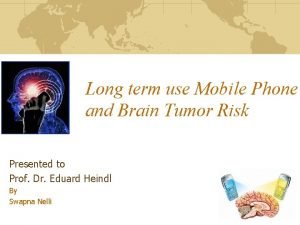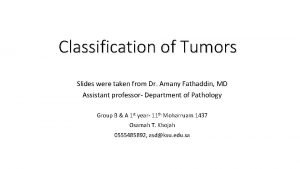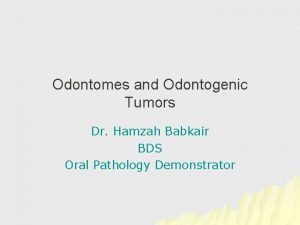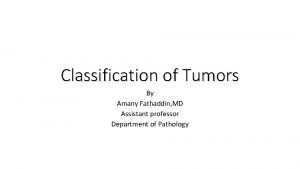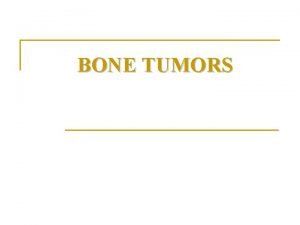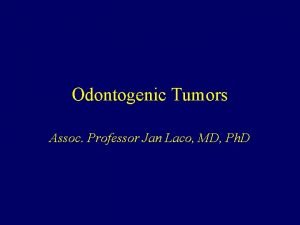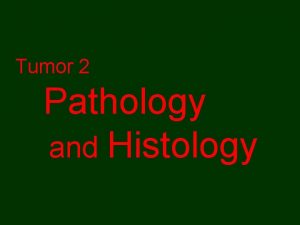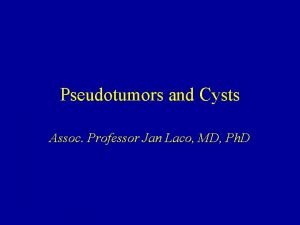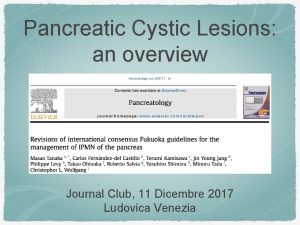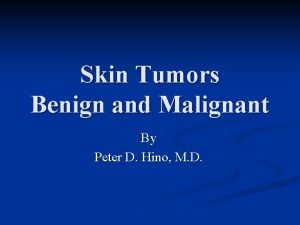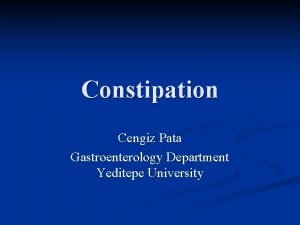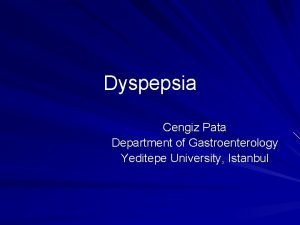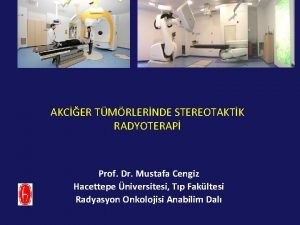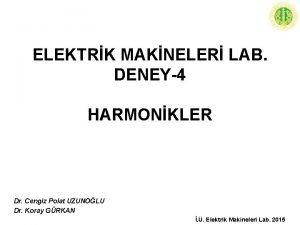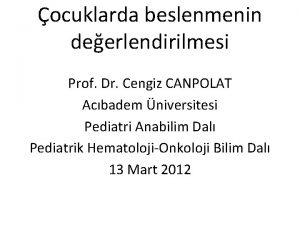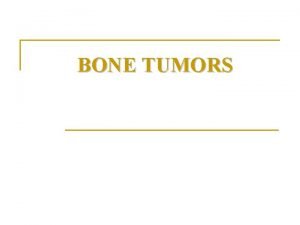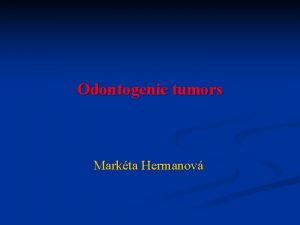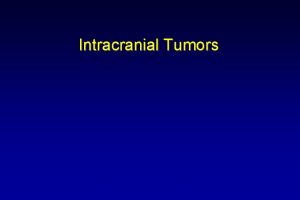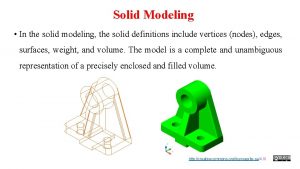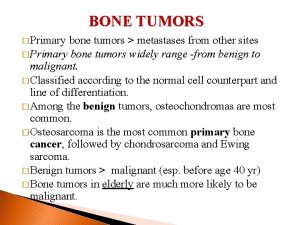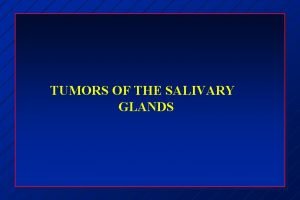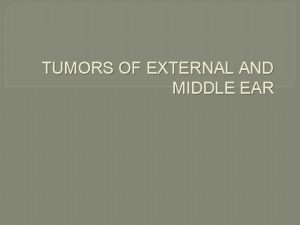Solid Tumors of Childhood Prof Dr Cengiz Canpolat











































- Slides: 43

Solid Tumors of Childhood Prof. Dr. Cengiz Canpolat 1

CNS Tumors Most common solid tm of childhood. There are inherited disorders that are associated with brain tms: Cowden’s Synd (PTEN, cerebellar dysplastic gangliocytoma) Li-Fraumeni (p 53, MB/astrocytoma) NF-1 (neurofibromin, astrocytoma, optic glioma) NF-2 (NF 2, schwannoma, meningioma) Nevoid Basal Cell Carcinoma (PTCH, MB) Tuberous Sclerosis (TSC 1 -2, Astrocytoma) Turcot’s Synd (Adenomatosis Poliposis Coli-DNA mismatch tamir gen defekti, MB) von Hippel Lindau’s Synd (VHL-DNA replikasyonu, hemangioblastoma) 2

Approximate Incidence of Common CNS Tms in Children 3

pathology Supratentorial Lesions 1. Cerebral hemisphere: low- and high-grade glioma, ependymoma, meningioma, primitive neuroectodermal tumor (PNET). 2. Sella or chiasm: craniopharyngioma, pituitary adenoma, optic nerve glioma. 3. Pineal region: Pineoblastoma, pineocytoma, germ cell tumors, astrocytoma. 4

pathology Infratentorial Lesions 1 -Posterior fossa: medulloblastoma, glioma (low more frequent than high grade), ependymoma, meningioma. 2 -Brain stem tumors: low- and high grade glioma, PNET Ventricular Lesions: Choroid plexus papilloma, choroid plexus carcinoma, neurocytoma. 5

CLINICAL MANIFESTATIONS Symptoms and signs are related to the location, size and growth rate of tumor: • Slow-growing tumors produce massive shifts of normal structures and may become quite large by the time they first become symptomatic • Rapidly growing tumors produce symptoms early and present when they are relatively small. 6

Clinical manifestations 1. Headache. In young children headache can present as irritability. Often worse in the morning, improving throughout the day. 2. Vomiting. 3. Disturbances of gait and balance. 4. Hemiparesis. 5. Cranial nerve abnormalities. 6. Impaired vision a. Diplopia (6 th nerve palsy) b. Papilledema from increased ICP may present as intermittent blurred vision c. Parinaud syndrome (failure of upward gaze and setting-sun sign, large pupils and decreased constriction to light). 7

Clinical manifestations (continued) 7. Mental disturbances – somnolence, irritability, personality or behavioral change, or change in school performance. 8. Seizures – usually focal. 9. Endocrine abnormalities: Midline supratentorial tumors may cause endocrine abnormalities due to effects on the hypothalamus or pituitary and visual field disturbances as a result of optic pathway involvement. 10. Cranial enlargement in infants (characteristic of increased ICP). 11. Diencephalic syndrome can be seen in patients aged 6 months to 3 years with brain tumors who present with sudden failure to thrive and emaciation. The syndrome is caused by a hypothalamic tumor in the anterior portion of the hypothalamus or the anterior floor of the third ventricle. 8

diagnostic evaluation Computed Tomography: Scans performed both with and without iodinated contrast agents detect 95% of brain tumors. Evaluating bony lesions Detection of calcification in tumor Investigating unstable patients because of the shorter imaging time Magnetic Resonance Imaging: No ionizing radiation exposure (especially important in multiple follow-up examinations) Greater sensitivity in detection of brain tumors especially in the temporal lobe and posterior fossa (these lesions are obscured by bony artifact on CT) Ability to directly image in multiple planes (multiplanar), which is of value to neurosurgical planning Ability to apply different pulse sequences which is useful in depicting anatomy (T 1 -weighted images) and pathology (T 2 -weighted images) Ability to map motor areas with functional MRI. 9

Treatment Surgery: 1. To provide a tissue biopsy for purposes of histopathology and cytogenetics. 2. To attain maximum tumor removal with fewest neurologic sequelae. 3. To relieve associated increased ICP due to CSF obstruction. Radiotherapy: Most patients with high-grade brain tumors require radiotherapy to achieve local control of microscopic or macroscopic residual. The wider use of ionizing radiation in pediatric brain tumors has resulted in improved long-term survival. The total dose of radiotherapy depends on: • Tumor type (which also influences volume of treatment) • Age of the child • Volume of the brain or spinal cord to be treated. 10

Treatment Chemotherapy: plays an expanding role in the management of recurrent disease and in many newly diagnosed patients. Tumors with a low mitotic index and small growth fraction are less sensitive to chemotherapy; tumors with a high mitotic index and larger growth fraction are more sensitive to chemotherapy. 11

Non-Hodgkin Lymphoma (NHL) NHL is cancer of immune sytem. NHL is approximately 10% of all childhood cancers Male: Female= 2: 1 or 3: 1 NHL is less common in childhood than adults. Histological types of NHL is even less in childhood than adults. Peak incidence is 5 -15 y. 12

Non-Hodgkin Lymphoma (NHL) Predisposing Factors: Genetic: Immunological defects (Bruton type of sex-linked agammaglobulinemia, common variable agammaglobulinemia, severe combined immunodeficiency ataxiatelangiectasia, Bloom syndrome Wiskott– Aldrich syndrome, autoimmune lymphoproliferative syndrome [ALPS]) • Post-transplant immunosuppression, e. g. post bone-marrow transplantation (especially with use of T-cell depleted marrow); post-solid organ transplantation • Lymphomatoid papulosis in children may evolve into or co-exist with anaplastic large cell lymphoma (ALCL) Drugs: Diphenylhydantoin, Infliximab and other immunosuppressive agents Radiation: Children treated with chemotherapy and radiotherapy for Hodgkin lymphoma Viral: Epstein–Barr virus (EBV), human immune deficiency virus (HIV) and possible link to human T-lymphotropic virus (HTLV). 13

NHL: Clinical Findings Histology B cell Abdomen, mediastinum(large cell only) Lymphoblastic Lymphoma Mediastinum, pleura, lymph nodes, bone Anaplastic Lymphoma lymph nodes, bone, skin 14

NHL: Diagnosis Histopathologic analysis is very important in diagnosis. Phenotypic and caryotypic analysis should also confirm the histologic diagnosis. Differential diagnosis from other small round blue tms of childhood is very important (Ewing’s S, NB, RMS). 15

NHL: Prognostic Criteria Large tm volume at diagnosis: p Presence of bone marrow and CNS disease at diagnosis: p Prolonged amount of time between treatments: p Incomplete remission at the first 2 months of treatment: p LDH and/or IL-2 R and/or uric acid high: p 16

NHL: Treatment Chemotherapy and surgery. XRT has very limited place in treatment plan. 17

Hodgkin lymphoma (HL) is characterized by progressive enlargement of the lymph nodes. It is considered unicentric in origin and has a predictable pattern of spread by extension to contiguous nodes 1. Etiology is unknown. 2. Comprises 8. 8% of all childhood cancers under the age of 20. 3. Overall annual incidence rate in the United States is 12. 1 per million for children under 20 years. 4. Incidence increases to 32 per million for adolescents 15– 19 years. 5. Bimodal age – incidence curve with one peak at 15– 35 years of age and the other above 50 years of age (incidence is highest among 15– 19 -year-olds). 6. Association with Epstein–Barr virus (EBV). 7. Incidence increased among consanguineous family members and among siblings of patients with HL. 8. In United States, increased risk of HL in families with higher incomes and higher education levels. 18

Hodgkin lymphoma RISK FACTORS: 1 -family history of HL 2 -EBV infections (EBV incorporated into the tumor genome has been most commonly reported with the mixed cellularity histologic subtype. In turn, this subtype is most common in children from underdeveloped countries, in males under age 10 years and in those with other immunodeficiencies 3 -socioeconomic status (There is an association between HL and socioeconomic status. In children less than 10 years of age and in underdeveloped nations, HL is associated with lower socioeconomic status and in households with more children. However, in young adult patients and in developed nations, HL incidence increases with higher socioeconomic status and with smaller households with fewer children 19

Hodgkin lymphoma Histology Hodgkin lymphomas (HL) consist of two disease groups, as was proposed in the Revised European. American Classification of Lymphoid Neoplasms (REAL classification) and incorporated into the 2008 4 th edition of the WHO Classification of Tumors of Haematopoietic and Lymphoid Tissues. These two groups are: • “Classical” HL includes the nodular sclerosis classical Hodgkin lymphoma (NSCHL), mixed cellularity HL (MCHL), lymphocyte-depleted (LDHL) and lymphocyte-rich classical HL (LRCHL) subtypes • Nodular lymphocyte-predominant HL (NLPHL). 20

Hodgkin lymphoma Clinical features 1 -Lymphadenopathy (90% of All Cases) Painless swelling of one or more groups of superficial lymph nodes; rarely painful. Cervical nodes involved in 60– 80% of cases; associated with mediastinal involvement in 60% of cases. Axillary, inguinal, mediastinal and retroperitoneal nodes also frequently involved. Involved nodes are discrete, elastic, painless and usually “rubbery”; tenderness is rare. 2 -Splenomegaly 3 -Systemic Symptoms (30% of All Cases) Intermittent fever (Pel– Ebstein), anorexia, fatigue, weakness, nausea, night sweats and weight loss. Mild itching may be seen in 15– 25% of patients with HL 4 -Pulmonary disease (17% of All Cases) cough and dyspnea 5 -Neurologic Manifestations 6 -Bone Disease (2% of All Cases) 7 -Bone Marrow Involvement (5% of All Cases) 8 -Liver Disease (2% of All Cases) 9 -Renal Manifestations 21 10 -Hematologic Manifestations

Hodgkin lymphoma Diagnostic investigations 1 -Surgical Excisional lymph node biopsy Bilateral bone marrow biopsies 2 -Imaging studies CT scan of neck, chest, abdomen and pelvis FDG-PET Technetium-99 bone scintography 3 -Laboratory studies Complete blood count Blood chemistries for renal and hepatic function Erythrocyte sedimentation rate Ferritin 22

Hodgkin lymphoma PROGNOSTIC FACTORS Advanced stage of disease (Stage IIB, IIIB, or IV disease) • The presence of B symptoms • The presence of bulk disease • Extranodal extension • Male sex • Elevated erythrocyte sedimentation rate • White blood cell count 11, 500/mm 3 or higher • Hemoglobin less than 11. 0 g/dl • The combination of B symptoms and bulky disease are inferior prognostic indicators 23

Hodgkin lymphoma Treatment 1 -chemotherapy 2 -raidotherapy 24

Neuroblastoma (NB) The neuroblastic tms (NB, ganglioneuroblastoma, and ganglioneuroma) are derived from primordial crest cells, that ultimately populate the symphathetic ganglia, adrenal medulla, and other sites. NB is the most common extracranial solid tm in children and is the most common cancer diagnosed in infancy. Median age at diagnosis is 17 months; 89% of patients at ages younger than 5 y and 97. 8% by 10 y of age. 25

Neuroblastoma (NB) The etiology of NB is unknown in most cases. There are few reports but not consistently confirmed: alcohol, seizure medications, diuretics, neurally active drugs, fertility drugs or hormones, maternal hair coloring products (? ? ? ) paternal occupation of electrical, farming, gardening, painting jobs (? ? ? ) Congenital abnormalities with NB is rare: Turner’s Synd, neurodevelopmental abnormalities, NF-1, Hirschprug dis, central hypoventilation (increased NB incidence) Down’s Synd (decreased NB incidence) 26

Neuroblastoma (NB) Most primary NBs occur within the abdomen (65%) The signs and symptoms of NB reflect the location of primary, regional, and metastatic disease. Paraneoplastic syndromes: Sweat, flushing, palpitation, hypertension (catecholamine secretion) Intractable secretory diarrhea, abd distention, hypokalemia (VIP secretion; usu mature NB) Opsomyoclonus (myoclonic jerking and random eye movement) or cerebellar ataxia (usu g outcome associated with MYCN but long-term nrl deficits; antineural antibodies? ? ). 27

Diagnosis of NB is established if: An unequivocal pathological diagnosis made from tm tissue by light microscopy, with or without immunohistology, EM, or increased urine (or serum) catecholamines or metabolites. BMA or Bx contains unequivocal tm cells AND increased urine (or serum) catecholamines or metabolites. 28

NB: Prognostic Criteria The most important clinical variables predictive of disease outcome are the age of the patient and the stage of disease at diagnosis. Differentiated histology is associated with localized tms (g). Normal ferritin, NSE, LDH (g, but not against MYCN) Hyperploidy (DI>1) (g in infants) 1 N-myc copy (g) Del 1 p (p) TRKA expression (g) 29

NB: Treatment Surgery plays a pivotal role in management for both diagnosis and treatment. Gross total resection improves survival. Chemotherapy is planned before surgery, if total resection surgery would be mutiliating. Radiotherapy is considered if margins are positive after the surgery. 30

Wilms’ Tm (WT) WT is the most common primary malignant renal tm of childhood. Male: Female=0. 92: 1 Most patients (78%) diagnosed between 1 -5 y. Peak age: 3 -4 y. Usually sporadic. Less than 1% could be familial. 31

WT and Congenital Abnormalities WAGR Synd (WT, Aniridia, GU abn, mental Retardation) Denys-Drash Synd (pseudohermaphroditism, degenerative renal disease like AGN or NS and WT) Beckwith-Wiedemann Synd (Hemihypertrophy, sporadic aniridia, omphlocele, visceromegaly) abdominal USG and alpha-FP levels q 3 mo till 5 y/o and q 1 y till growth stops. Sporadic hemihypertorphy Cryptorchidism (male only) Hypospadias (male only) 32

WT: Clinical Findings Abdominal swelling or presence of and abdominal mass are the most common presenting symptoms. Abdominal pain, gross hematuria and fever and hypertension are the other frequent findings. Increased EPO expression could lead to polyctemia. 33

WT: Prognostic Factors Anaplastic histology (p) Presence of para-aortic lymph nodes (p) Since the treatment is more effective the prognostic significance of age and tm size does not exist anymore. LOH 16 q (p) Aneuploidy (p? , g? ) Relapsing after more than 15 months after the diagnosis (g) 34

WT: Treatment Surgery. Chemotherapy. Radiotherapy in selected patients. 35

RMS and other STS Soft-tissue sarcomas (STS) constitute a eterogeneous group of malignant tumors that are derived from primitive mesenchymal cells. These tumors arise from muscle, connective tissue, supportive tissue and vascular tissue. They are locally highly invasive and have a high propensity for local recurrence. When they metastasize, it is usually via the bloodstream and, less commonly, via the lymphatics. The STS can be divided into two groups: 1 -rhabdomyosarcoma (RMS) 2 - non-rhabdomyosarcoma soft-tissue sarcomas (NRSTS) 36

RMS is the third most common solid extracranial tumor, following neuroblastoma and Wilms’ tumor • It accounts for 3% of all malignant neoplasms • There is a slight male predominance with a male: female ratio of 1. 4: 1 • There are two age peaks: 2– 6 years and 15– 19 years. The adolescent peak has primarily been noted in males • Incidence in African-American females is half that of Caucasian females. Incidence is lower in Asian populations residing in Asia or the West. 37

RMS Risk factors • Germline mutations of the p 53 suppressor gene, as in Li. Fraumeni familial cancer syndrome. There is an association between early onset breast cancer, sarcomas, brain tumors and adrenocortical tumors in family members • Ionizing radiation • Neurofibromatosis with NF 1 • Associated with anomalies of the central nervous system (CNS), genitourinary system, gastrointestinal system and cardiovascular system (i. e. Beckwidth–Weidemann syndrome) • Associated with maternal and paternal use of marijuana and cocaine and first-trimester pre-natal X-ray exposure, possibly as an environmental interaction with a genetic trigger 38

RMS Pathologic classification 1 -embryonal (Head and neck, orbit, genitourinary) -botryoid variant (bladder, vagina, nasopharynx, bile duct) -spindle cell variant (paratesticular) 2 -alveolar (extremity, trunk) 3 -RMS-NOS (extremity, trunk) 39

RMS Clinical manifestations Neck: soft-tissue mass, hoarseness, dysphagia Nasopharynx: sinusitis, local pain and swelling, epistaxis Paranasal Sinus: sinus obstruction/sinusitis, unilateral nasal discharge, local pain and swelling, epistaxis Middle ear/mastoid: chronic otitis media – purulent blood stained discharge, Polypoid mass in external canal, Peripheral facial nerve palsy Orbit: proptosis, ocular palsies, conjunctival mass Vagina and uterus: vaginal bleeding, grapelike clustered mass protruding through vaginal or cervical opening Prostate: hematuria, constipation, urinary obstruction Bladder: urinary obstruction, hematuria Paratesticular: painless scrotal or inguinal mass Retroperitoneum : abdominal pain, abdominal mass, intestinal obstruction Pelvic: constipation, genitourinary obstruction Extremity/trunk: asymptomatic or painful mass 40

RMS Diagnostic evaluation Magnetic resonance imaging for extremities, body wall and head/neck Computed tomography for intrathoracic, retroperitoneal, paraspinal, skull base Ultrasound for paratesticular, bladder/prostate or biliary tree Metastatic workup CT scan: chest , abdomen Bone scan Bilateral bone marrow aspiration and biopsy PET scan for determining initial extent of disease and to monitor response to therapy 41

RMS Risk factors Extent of disease Residual disease after surgery Patients with smaller tumors (<5 cm) have improved survival compared to children with tumors >5 cm Those with metastatic disease at diagnosis have the worst prognosis Nonparameningeal head and neck sites, Nonbladder/nonprostate male and female genitourinary tract sites and biliary tract are considered “favorable sites”; all other sites are considered “unfavorable. ” Children between 1 and 9 years of age have a better prognosis than those older than 9 years of age Risk factors for NRSTS Extent of resection Metastasis Tumor size Location (intraabdominal) Grade 42

RMS and NR-STS Treatment 1 -surgery 2 -chemotherapy 3 -radiotherapy 43
 Stomatosit
Stomatosit Cengiz canpolat
Cengiz canpolat Cengiz canpolat
Cengiz canpolat Response evaluation criteria in solid tumors (recist)
Response evaluation criteria in solid tumors (recist) Mild ascites
Mild ascites Prof dr cengiz yalçınkaya
Prof dr cengiz yalçınkaya Prof dr cengiz kılıç
Prof dr cengiz kılıç Early childhood adolescence
Early childhood adolescence Chest wall tumors
Chest wall tumors Mobile phone brain tumour
Mobile phone brain tumour Classification of tumors
Classification of tumors Chondrosarcoma
Chondrosarcoma Odontogenic tumors
Odontogenic tumors Brain tumors
Brain tumors Teratoma
Teratoma Classification of tumors
Classification of tumors Bone tumors
Bone tumors Ameloblastoma rtg
Ameloblastoma rtg Lipoma
Lipoma Cervical stenosis cervix
Cervical stenosis cervix Odontogenic tumors classification
Odontogenic tumors classification Spinal cord
Spinal cord Thyroid tumors
Thyroid tumors Intraductal papillary mucinous neoplasm
Intraductal papillary mucinous neoplasm Peter hino md
Peter hino md Enneking
Enneking Labil duygulanım nedir
Labil duygulanım nedir Cengiz polat art
Cengiz polat art Types of laxatives
Types of laxatives Mehmet cengiz çolakoğlu
Mehmet cengiz çolakoğlu Cengiz pata
Cengiz pata Tansın cengiz
Tansın cengiz Dr mustafa cengiz
Dr mustafa cengiz Cengiz balkan
Cengiz balkan Cengiz yaman
Cengiz yaman Cengiz topel cesedi fotoğrafları
Cengiz topel cesedi fotoğrafları Cengiz polat uzunoğlu
Cengiz polat uzunoğlu Cengiz camci
Cengiz camci Cengiz kılıç psikiyatri
Cengiz kılıç psikiyatri Theropatic
Theropatic Cengiz kurtman
Cengiz kurtman Cengiz akay
Cengiz akay Example of solid solutions
Example of solid solutions Crystal solid and amorphous solid
Crystal solid and amorphous solid
